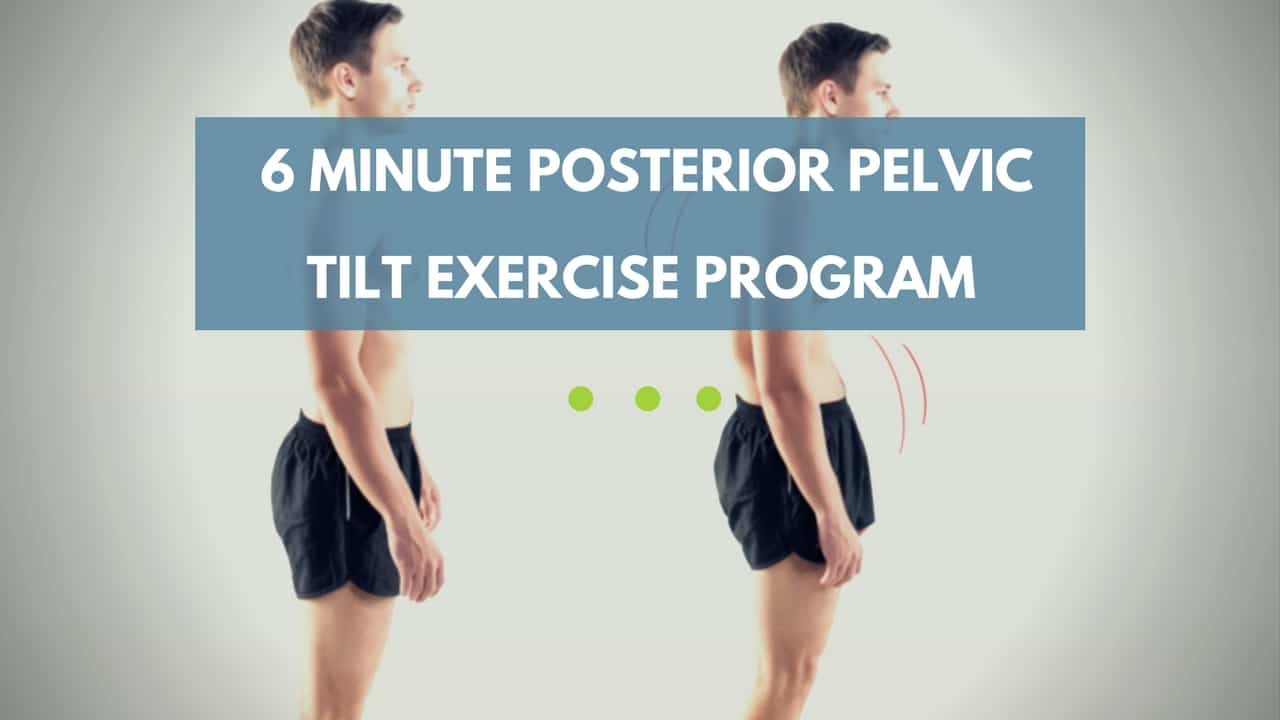
Developing a posterior pelvic tilt not only damages your posture, it also leads to unbearable back pain and muscle imbalances severely lowering your capacity for functional movement.
Sitting for extended periods can wreak havoc on your body simply because it’s not something we were designed to do for hours every day! [1]
Our ancestors didn’t outrun tigers, forage for berries or chase down their perfect mate by sitting on their asses all day – no, they got up and made things happen.
Prolonged sitting eliminates your body’s need to activate the various muscles responsible for hip and spine flexion, extension, and stabilization. Sitting has turned you into an (arguably) evolved human being with a flat ass and ridiculously dexterous thumbs for texting.
But, this thumb development is no consolation for the pelvic dysfunction that can result.
Depending on your situation, you may have developed either an anterior or a posterior pelvic tilt that has ruined your posture.
Today we’re going to go into the lesser known of the two pelvic tilt dysfunctions, the posterior pelvic tilt (anterior pelvic tilt is more common).
Specifically, we’ll go through:
- What is a posterior pelvic tilt
- What causes a posterior pelvic tilt
- The potential issues involved
- How to test for posterior pelvic tilt
- A quick 6 minute routine for regaining your neutral pelvic tilt and your posture*
Regaining the natural position of your pelvis will not only make you look taller and more attractive, it will also help you get more mileage out of your lumbar discs and avoid being mistaken for a jumbo shrimp when you’re older.
What is a Posterior Pelvic Tilt
Pelvic tilting is a postural fault where the pelvis rotates in either an anterior or posterior direction.
With the posterior pelvic tilt, the tailbone tucks in and under the body so that the anterior side of the hips rotate upwards toward the stomach.
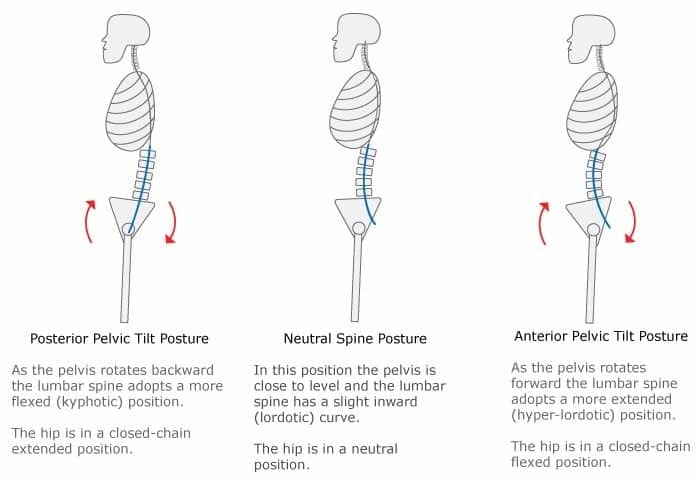
To help understand pelvic tilt a little better, I want you to imagine your pelvis is a bucket of water – I know it’s weird, but trust me; this analogy will make sense in the end.
Tilting your bucket in either direction will result in water spilling out, and you don’t want that. I mean, what good is a bucket if it can’t hold water?
Now, if you suffer from a posterior tilt, you’re going to be splashing and spilling water out the back side of the bucket all over your ass and down the back of your legs.
For this reason, it’s very important that your bucket of water (pelvis) be set in a good position to support your spine.
What Causes Posterior Pelvic Tilt
People who suffer from posterior pelvic tilt are often the people who also spend a lot of time sitting or are women who have recently given birth.
What these types of people have in common is an imbalance of strength in the muscles that stabilise the lower half of the core.
This imbalance is a result of the muscles being under, or over, developed in relation to other muscles working as a counterbalance (pulling in opposing direction).
This imbalance causes the pelvis to tilt backwards and down flattening the natural lordotic curve in your lumbar, making it appear as if you have no butt.
Imagine you’re sitting on a seesaw, and you have a friend who is about the same weight as you sitting on the other end.
If you wanted to, you could balance the seesaw parallel to the floor with both you and your friend’s feet dangling above the ground.
Now, imagine instead of your friend being on the end of the seesaw, it was the famous Austin Powers villain “Fat Bastard”.

Do you think the seesaw would be able to remain straight and balanced? – Hell no, it wouldn’t!
And this is what’s happening to your pelvis when certain muscles aren’t strong enough to do their job, throwing pelvis position out-a-whack.
Generally, posterior pelvic tilt is caused by the following:
Tight Abdominals
When the anterior muscles of the core become too tight or overdeveloped, compared to the counterbalancing muscles of the back, they can pull and tilt the pelvis posteriorly and flatten out the natural lordotic curve in the lumbar spine.
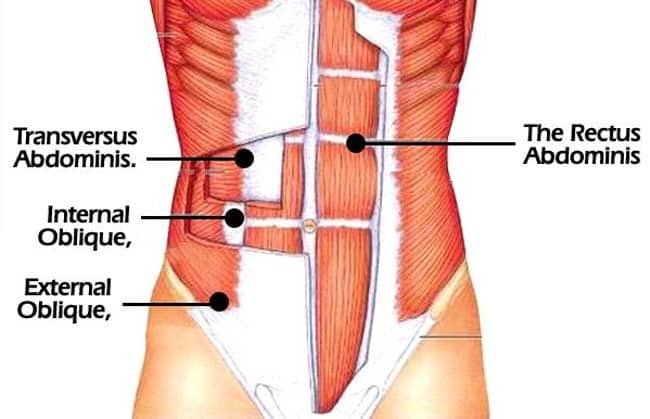
Weak Lumbar Extensors
The role of the spinal extensor muscles is to stabilize the natural lordotic curve of the lumbar, so that the weight of the body can be efficiently distributed and supported when standing or sitting.

When these muscles are weak, or the antagonist muscles in the anterior core overpower them, the pelvis will tilt posteriorly and flatten the lumbar.
These muscles include the:
- Lumbar Multifidus
- Erector Spinae
- Quadratus Lumborum (QL)
Lax Psoas
The posas originates at the 12th thoracic vertebrae, the 1st and 4th lumbar vertebrae and the lateral aspects of the discs and attaches itself to the lesser trochanter of the femur (head of the thigh bone).
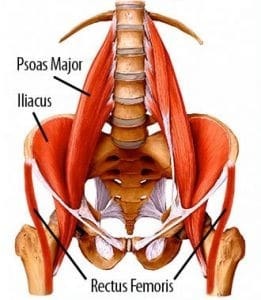
One of the two muscles that make up the Iliopsoas, the psoas plays a role in lumbar flexion, pelvic movement, and stabilization.
This muscle is extremely important for maintaining the natural curve of the lumbar, and if it becomes weak, the pelvis will tilt posteriorly as the hip extensors begin to dominate the relationship.
What About the Glutes and Hamstrings?
Usually, when someone suffers from a posterior pelvic tilt, they will aggressively stretch their hamstrings and smash their glutes with a lacrosse ball to try and loosen up the muscles.
It’s a common misconception that the glutes and hamstrings are responsible for posterior pelvic tilt. But, the truth is, they typically don’t influence it as much as the other factors mentioned above.
This is because, even though the hamstrings are tight where they attach to the hip, they can also be lengthened at the knee. Tight hamstrings should result in knee flexion, but most people suffering a posterior pelvic tilt often stand with hyperextended knees to compensate.
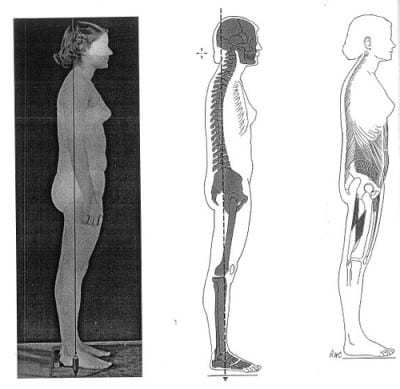
As you can see from the image above, a posterior pelvic tilt can occur even if the hamstrings are in extension. Thus, pointing to other factors as the more likely cause.
Real World Problems Caused By Posterior Pelvic Tilt
Apart from the obvious pain, knotting and shortening of the tight muscles mentioned above, posterior pelvic tilt sufferers will also experience a number of other related issues as a result of this pelvic position.
The problems associated with posterior pelvic tilt aren’t restricted to the pelvis, as it also causes issues up and down spine in a domino effect.
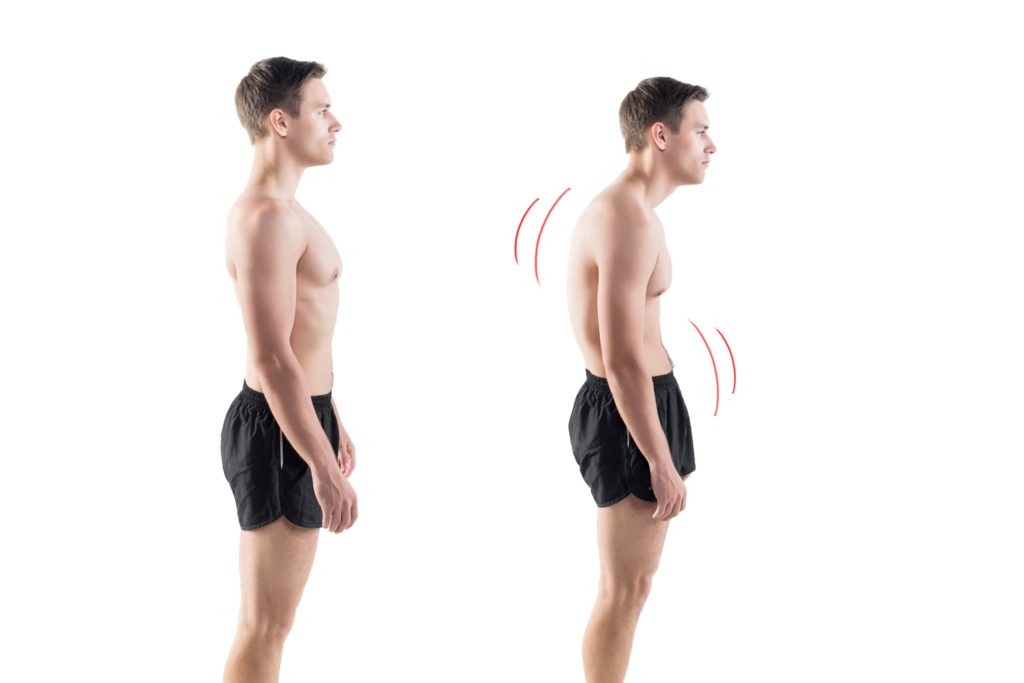
Any dysfunction in one segment of the spine – i.e. cervical, thoracic or lumbar – will affect other segments as they will compensate to bring balance back to the body.
Usually, people who suffer from posterior pelvic tilt will also experience thoracic kyphosis, which is the excessive rounding of the thoracic spine (upper back), typically accompanied by a forward poking head.
As the upper back rounds forward the compressive load will be greater in the thoracolumbar and lumbar regions of the spine. [2]
If you’re suffering from posterior pelvic tilt and are performing weighted exercises – like squats – that load the spine with a compressive force, the lumbar discs will bear the brunt of that weight.
When the spine is unevenly loaded it can cause prolapsing or herniation of discs, as the vertebrae move closer together on the anterior side creating pressure on the posterior side.

Disc herniation can place some serious restrictions on many common movements. Read this for more information on the types of movements you’ll want to avoid.
Lumbar disc damage is also one of the main causes of sciatica as the protruding disc impinges the sciatic nerve, leading to pain, tingling, numbness and weakness in the lower limbs. [3]
How to Test for Posterior Pelvic Tilt
To test whether your pelvis is in a good position, or if you have a posterior pelvic tilt, you’ll want to find and assess the line between your:
- Posterior Superior Iliac Spine (PSIS)
- Anterior Superior Iliac Spine (ASIS)
You can do this test yourself with the help of a mirror, but for best results you should ask a friend, one that wouldn’t mind touching your pelvis, to help you out.
- Find the PSIS point, which is located just below the dimples of your lower back and move your hand to the right (or left) palpating your fingers until you find the bony point
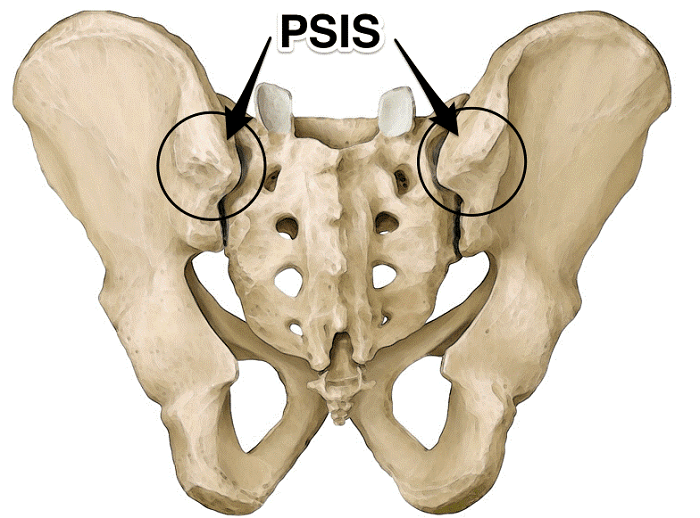
- Locate the ASIS which is the super bony part in the front of your hips roughly inline with your PSIS
- Draw in imaginary line from your PSIS to your ASIS
The line form your PSIS should be descending at an angle of roughly half an inch. Females will naturally have a slightly higher angle than males, but either way it should be half and inch give or take.

However, if the line between your PSIS and ASIS is horizontal or closer to horizontal, there’s evidence to suggest you’re suffering from a posterior pelvic tilt.
Ok, now you know what the problem is, and know how to identify it, what can you do to fix it?
The 6-Minute Posterior Pelvic Tilt Exercise Program
Below, I have provided a quick 6-minute routine to help you reset your pelvis into neutral position and treat the symptoms of posterior pelvic tilt*.
This routine works to:
- Stretch and lengthen the muscles that have become short and tight
- Release anything that may be restricting the mobility of the hip capsule
- Strengthen and coordinate the agonist and antagonist stabilizer muscles to eliminate imbalances causing posterior pelvic tilt
- Train and improve neural control in functional movements so that the proper patterns are ingrained in the movement
FREE DOWNLOAD: 6 MINUTE POSTERIOR
PELVIC TILT ROUTINE CHEATSHEET

To fix your posterior pelvic tilt, you’ll need to perform these exercises using a slight anterior pelvic tilt. This will ensure you’re not defaulting into a bad position and work to normalize your pelvic tilt.
Once you feel your pelvis is normalized, you can run through these exercises again, this time with a neutral pelvic tilt.
0 – 1st Minute: Pressup to Ab Stretch
Use this first stretch to lengthen your tight and stiff abdominal muscles.

- Gently work on thoracic extension by pushing your hands into the ground to raise your shoulders – make sure you relax your back in this movement and let your arms do all the work
- Gently increase the range of motion as you go, exhaling with each extension
- Aim for about 10 reps of this exercise in the first minute of the routine
1st – 3rd Minute: Supine Active 1-Leg Knee Extensions

- Flex your hip so there is a 90° angle between your femur and your hip, keeping your leg bent
- Make sure you maintain the natural curve in your lumbar with an anterior pelvic tilt. Use your hand to check before you progress with the exercise
- Once you have an anterior tilt, slowly extend your leg so that your foot heads to the sky and hold for 2 seconds
- Repeat this 10 reps per side
- Once you feel your pelvis start to normalize, you can repeat this exercise with a neutral pelvic tilt
3rd – 5th Minute: Superset Bent-Knee (or Straight-Leg Raises) / Prisoner Deadlift
Perform this superset by doing 10 reps of leg raises followed by 10 reps of prisoner deadlifts. Continue repeating this superset for two minutes straight.
Superset Bent-Knee (or Straight-Leg Raises):

- Lay flat on your back with your knees bent and feet flat on the floor at about hip width
- Aim to achieve a slight anterior pelvic tilt and place your hands under the curve of your lumbar spine to check
- With your hands under your lumbar, brace your abs to help set your core and pelvis in a good position
- Take your hands away now and place your hands palm down on the ground at about a 45° angle from your body
- Using your arms, your core and your pelvis for support lift your legs by flexing your hip to a 90° angle and then bring them back to the floor
- Repeat this movement for 10 reps or stop if you experience technical failure
For a more advanced variation, perform this exercise with your legs straight. You might feel more comfortable performing the straight leg variation holding onto a pole or some other sturdy structure with both hands above and behind your head for support.
Prisoner Deadlift:

- Retract your shoulders back and down, brace your core and make sure your chin is tucked
- Bend your arms and raise your hands to the side of your ears as if you were a prisoner being held at gunpoint by the prison guards
- Hinge at the hips and focus on pushing your butt backwards as you bend
- Make sure your elbows stay retracted throughout the movement. If you let your elbows move forward you’ll start to round at the thoracic spine and lose the natural lordotic curve in your lumbar
- Squeeze your glutes to help drive you back into the standing position
- Repeat this exercise for 10 reps
5th – 6th Minute: Prisoner Squats
The arm position in both the prisoner deadlift and the prisoner squat help to minimize thoracic kyphosis, which can pull your pelvis into a posterior pelvic tilt.
Perform this exercise with a mirror to ensure there is no posterior pelvic tilt (or butt wink) at the bottom position by stopping before it happens.

- Retract your shoulders back and down, brace your core and make sure your chin is tucked
- Bend your arms and raise your hands to the side of your ears as if you were a prisoner being held at gunpoint by the prison guards
- Descend into the squat making sure to hinge at the hips and drive your knees outward as you go down
- Make sure you stop the squat before your pelvis begins to tilt posteriorly
- Drive into your heels and squeeze your glutes to stand back up in the starting position
- Repeat this exercise for 10 reps
For the best results*, perform this routine at least once a day to help you return to correct posture and the neutral tilt of your pelvis.
*Although the information shared on PrecisionMovement.coach is based on a well-researched, scientific approach towards health and fitness, every person is unique and individual results may vary.
To see if you’re improving, it’s always a good idea to test and retest as you progress. Use the PSIS – ASIS angle test mentioned above to periodically reassess your pelvic position.
Wrapping up today’s subject, a posterior pelvic tilt isn’t as common as the anterior pelvic tilt, but it does bring about issues that need to be addressed. Strengthening weak muscles, lengthening tight ones and inter and intramuscular coordination at end range should be your first goal in solving this problem. That and getting off that damn chair every now and then!
FREE DOWNLOAD: 6 MINUTE ANTERIOR
PELVIC TILT ROUTINE CHEATSHEET
Original article and pictures take www.precisionmovement.coach site
Комментариев нет:
Отправить комментарий